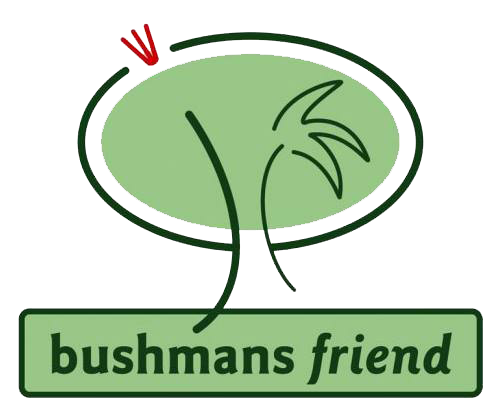
Purchase recommended products The classic New Zealand identification guide. Every home should have one. Buy it here. A practical field guide to New Zealand's native edible plants. Andrew Crowe. Our most popular book. Pohutukawa Diana Adams Art Print |
Rainbow Forest - A Magic Forest Walk - New Zealand Nature Sounds Music CD
Contact : Bushmansfriend 73 Campbell Rd. Totara North RD2 Kaeo Northland New Zealand Ph: 09 4051844
Pohutukawa Diana Adams Art Print
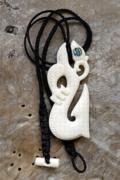
Hand carved Bone, Jade, Wood & Pearl shell pendants, carvings, gifts & art from New Zealand
Lonely Planet Tramping in New Zealand
TE Araroa: the New Zealand Trail: One Man Walks His Dream
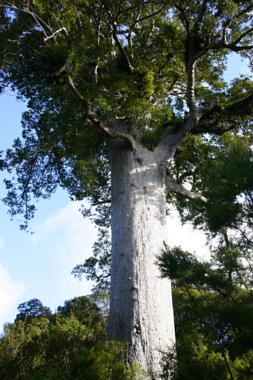 | The mighty Kauri In all its aspects and characteristics kauri is a most excellent tree. It produces an outstanding timber or world reputation. Kauri heads that group oftimbers whenever standards of excellence are quoted. The even grained wood is suitable for all but the most specialized needs.
|
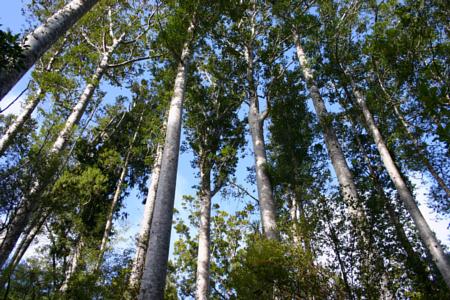
Kauri is a large tree up to 30m and rarely to 60m. tall. The bole of the trunk may be commonly up to 3m. in diameter andoccasionally to 7m. There are many records of trees yielding logs 7m in diameter and 24m. long. The bole is always straight, often branch-free, columnar, with little or no taper.
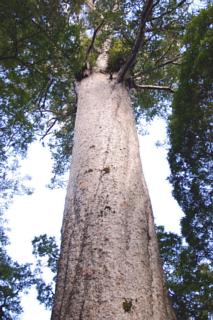
The bark is ash grey and smooth. Scale in fla kes reveal a brown inner bark. Large mounds of shed bark and litter collect at the base ofthe trunk.
On mature trees the branches become massive up to 800mm in diameter and are deeply impregnated with resins that produce timber ofsuperior lustre and colour. Gnarly burrs can occur. The crown in young trees is narrowly conical and in mature trees massive, fla t topped or fan shaped , spreading to a diameter of 30m.
The root system serves the two functions of anchoring the massive structure and feeding the living body. Long lateral roots that usuallyexceed the mature crown in spread, radiate outwards and from which grow strong peg roots that anchor the tree. Fine lateral roots are prominent on the surface and feed the plant by absorbing the nutrients of the decomposing litter.
The leaves of young trees are up to 10cm x 12mm lanceolate and in the open may have reddish brown tint. Adult leaves are smaller to3.5cm and are blunt tipped.
The male and female flowers and cones are found on the same tree. The female flowers are small, green, spherical and develop into ripecones in 18 mont hs. The female cones are up to 80mm in diameter, carried at the end of short branches.
Kauris natural distribution is no furth er south than latitude 38-a line from Kawhia to Opotiki. Its present distribution to the warmnorth appears to be the outcome of previous climates. Seedlings can withstand a few degrees of frost. It can be grown, siviculturally, in the extreme south of South Island, displaying growth rates similar to that in the north.
It is tolerant of a wide range of soils from swamp, to shallow stony soils of steep hill country or heavy clays. Kauri soilsdevelop podzol profiles as the decaying litter washed with rain secretes acids into the soil. These acidic forests stimulate leaching of soil minerals and the formation of a tough impenetrable dark pan. Soils on which kauri once grew are notoriously difficult for farming.However, these podzolic clays have produced the whitest clays in the world mined at Matauri Bay Whangaroa.

The cone is a particularly handsome oval shape about the size of a small tennis ball when ripe. They mature in March and April. Collect the first and second week of March. The litter from the tree turns the ground goldenbrown at this time of the year. Source fruiting trees in late spring and wait until the trees begin there annual leaf fall before picking. In the cone, a single winged seed is attached to each scale, with the exception of the apical and basal scales. 50-110 seedsper cone. 90-110 seeds per gram. The weight of each seed may vary considerably from 0.0065g- 0.0312g, depending on where in the cone the seed was formed. The heavier seeds are generally found in the centre of the cone. Seed viabillity approx. 50% per cone. The conedisintegrates on the tree releasing the seed to the wind. Old reports mention the large number of cones that fall prematurely to the ground due to the depradtions of the Kaka.(Nestor occidentalis). This is no longer a common occurrence on the mainland, although Kaka shred theconesin order to eat the ripening seeds on Little Barrier Island. A wet summer can cause the infection of the cones with the fungous disease Pestalozzia funerea .
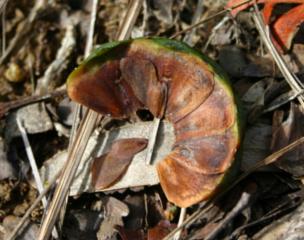
The seed should be sown immediately on collection in a free draining mix in a deep seed tray. Seed germination decreases to less than 1% within 8 months. Do not remove the wing from the seed as this may act as a wick to aid water absorption. Sow seed down and wing up, in a moist,warm environment. Light is necessary for germination. If conditions are suitable germination may proceed within a week of sowing and may continue spasmodically until early spring. The seedling is from 4-6 cm. high with 2 lanceolate cotyledons. The single, long, fleshy,taproot may be 8 cm. in length at this stage. 4 to 5 months after germination the seedling may be 10 cm high with a deep reaching tap root and a few fibrous laterals. They grow well in a long bag PB10 size. As they grow they can put on 10 cm spurts in a week but only once or twice ayear.
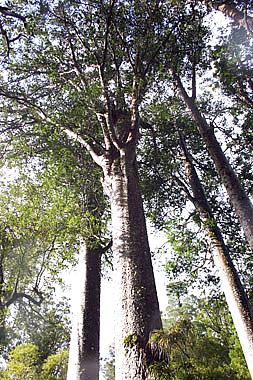
A little before noon Messrs. Williams and Davies walked with me to part of a neighbouring forest, to show me the famous kauri pine. I measured one of the noble trees,and found it thirty one foot in circumference above the roots. There was another close by, which I did not see, thirty three feet; and I heard of one no less than forty feet. These trees are remarkable for their smooth cylindrical boles, which ran up to a height of sixty, and evenninety feet, with a near equal diameter, and without a single branch. The crown of branches at the summit is out of all proportions small to the trunk; and the leaves are likewise small compared with the branches. The forest here was almost composed of the kauri; and the largesttrees from the parallelism of their sides, stood up like gigantic columns of wood.
Charles Darwin The Voyage of the Beagle
Written from Waimate Northland
I recommend the following books on New Zealand native plants
100 Best NZ Native Plants for Gardens
The Reed Field Guide to New Zealand Native Trees
Trees and Shrubs of New Zealand
Gardener's Encyclopaedia of NZ Native Plants
A Photographic Guide to Ferns of New Zealand
New Zealand Trees and Shrubs: A Comprehensive Guide to Cultivation and Identification
From Weta to Kauri: A Guide to the NZ Forest
Which Native Forest Plant? (Which S.)
Articles